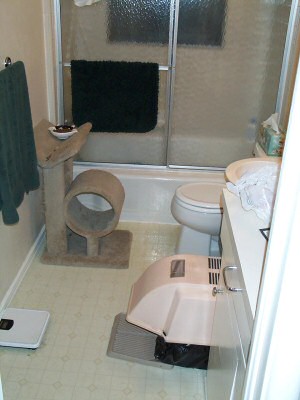Amelia the Cat and I agreed to try to work out our relationship again. If I scoop out her litter every day or two, she agreed to try not to poop around the house anymore.
Author: Aren Cambre
Always underpay hospital bills, always double check “explanation of benefits”
A truism: health care providers are quick to overcharge, slow to refund.
This week I learned six lessons to help deal with this:
- Pay as little as you can when you leave the provider. This may not work at a doctor’s office because the bill is cut and dried. But hospitalizations are different. Before you leave the hospital, the friendly hospital extortionist comes by to get as much out of you as she can. Pay the absolute minimum you can possibly pay. It’s better to get a bill later–after the claim with insurance is settled–than it is to overpay and fight for a refund.
- Don’t pay another cent until the claim is settled. That’s right, until you have the hot little explanation of benefit (EOB) in your hands, don’t pay another cent, except under duress.
- Only pay what the EOB says you owe. The EOBs should show exactly what the service provider billed your insurance, any discounts, what your insurer paid, and what you owe. On my insurance, what I owe is the sum of the “deductible” and “copay” fields. Sometimes there are also “non-covered charges.” Do not assume you have to pay the non-covered charges. See the next section.
- Question non-covered charges. Sometimes non-covered charges are billing errors. One of my EOBs for a doctor’s visit had $160 of non-covered charges. It turns out that the doctor mis-coded two items. Had I not caught this, I would have owed my doctor all that money. An example legitimate non-covered charge that you would have to pay could be a hospital room upgrade, such as a private room versus a shared room.
- Double-check that you actually paid what the EOB says you owe. I printed out every medical payment for the past year and found a corresponding EOB for payment. By double-checking all of this, I have found that I am owed several hundreds of dollars.
- If you are owed money, be persistent. None of the five medical care providers I have dealt with this year have voluntarily refunded a single cent I am owed. In fact, had I not called them out on it, one provider would have permanently sat on $500 it owes me. (It was a really dumb billing mistake: one line item was entered twice.) Take careful notes on each call, and be prepared to speak to several people before you get everything resolved.
Attention to detail can easily save you a ton of money. I’m on track for recovering a few hundred dollars for 2004.
Trial separation
 Kitty and I are on a trial separation.
Kitty and I are on a trial separation.
For the next few days, she will live in a special resort, pictured at right. While she’s at that resort, she will either learn that it’s OK to use the litter box, even if it’s not exactly how she wants it, or she will find a new home.
Pooping all over my house is no longer acceptable.
She has a tough choice to make.
My crime fighting for the day
This morning, as I was backing out of my driveway, I saw an aqua blue, four-door 1995 Chevrolet Cavalier with very dark tint race off from the trailer of the mowers who were mowing a neighbor’s lawn. The Cavalier raced off quickly, and the mowers’ expressions showed that something wrong just happened.
I was able to catch up to the criminal at the traffic signal leaving my neighborhood. I got his license number. The guy may have wanted to go south, but I think he noticed I was recording his license number, so he instead darted north, almost causing a rear end collision as he raced into traffic. I didn’t try to keep up with him because he was driving erratically, obviously fleeing.
I reported this to 911 within minutes as a suspicious activity call, and I also called the owner of the mowing company. He confirmed that $400 of equipment was just stolen.
I hope that since I reported the license plate number, something good may result from this.
I was able to get more of the car’s details through www.publicdata.com. It can be a good idea to purchase searches from this site!
EDIT: I called the lawn mowing company owner a few days later. He said that the police were not able to do anything because nobody got a good visual description of the thief.
85th percentile speed
The commonly accepted method of setting speed limits is to unobtrusively measure the 85th percentile speed of free flowing traffic. This is a speed that separates the 15% fastest drivers from the other 85%.
The theory behind this is twofold:
- Speed-related safety problems are concentrated in the fastest 5%, so the 85th percentile speed clearly criminalizes those 5% and allows for a small enforcement cushion.
- If you plot all measured speeds on a graph, you will get a bell curve. The 85th percentile speed is the break in the upper end of the bell curve.
Interestingly, in actual practice, speed limits are often set in the 30th to 50th percentile, meaning that anywhere from 50% to 70% of all drivers on any roadway are criminalized.
Seems goofy, doesn’t it?